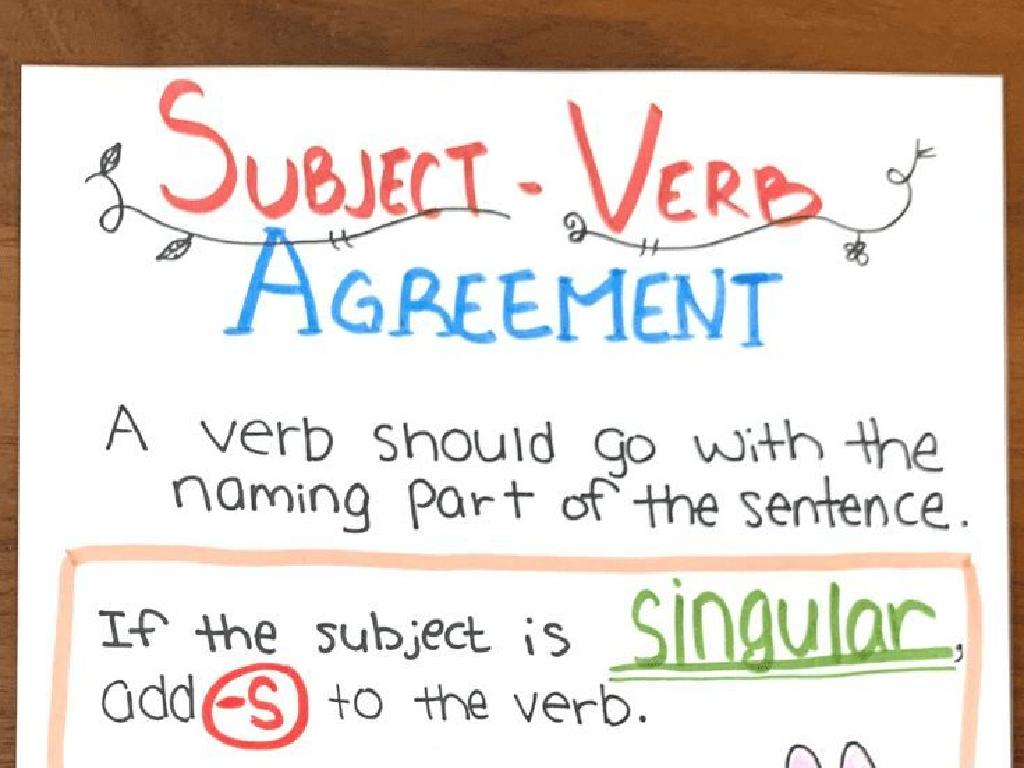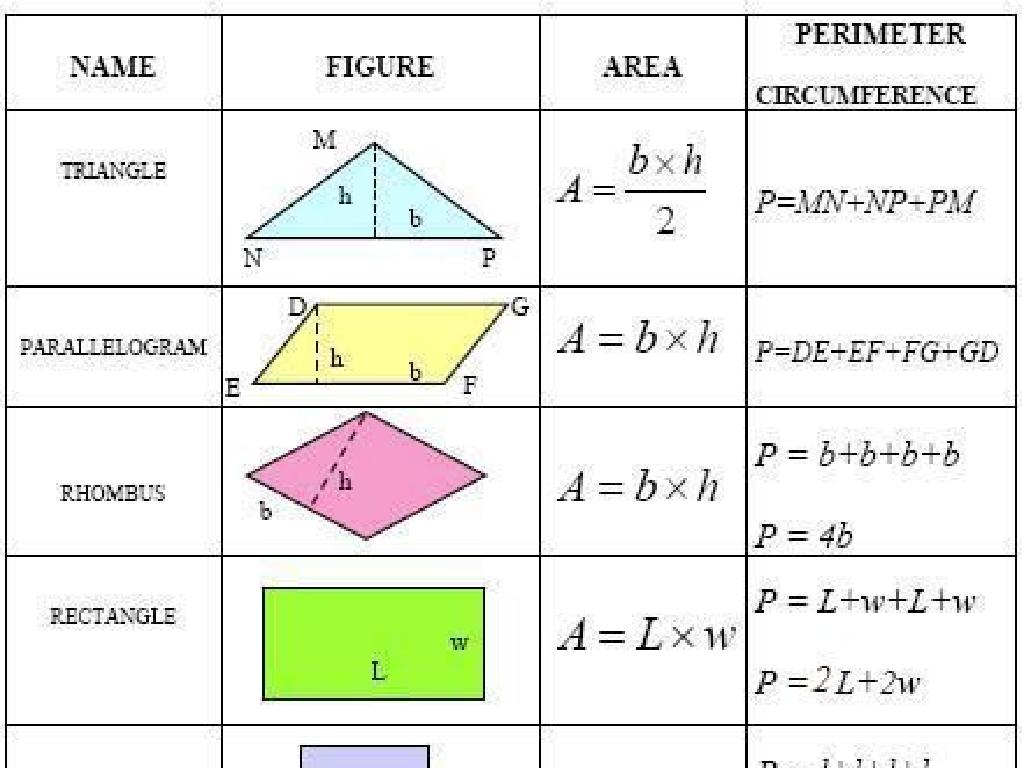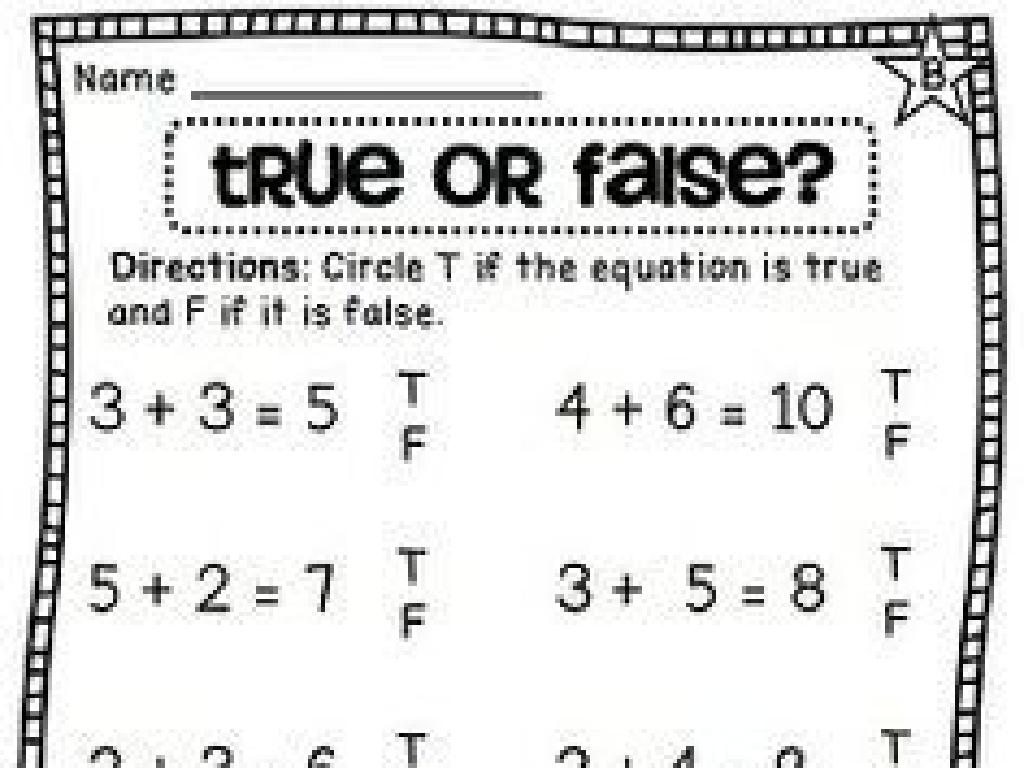Multiply Fractions By Whole Numbers: Word Problems
Subject: Math
Grade: Fourth grade
Topic: Multiply Fractions And Whole Numbers
Please LOG IN to download the presentation. Access is available to registered users only.
View More Content
Today’s Adventure: Multiplying Fractions by Whole Numbers
– Understanding fractions and whole numbers
– A fraction represents a part of a whole, and a whole number is a complete unit.
– Steps to multiply fractions by whole numbers
– Multiply the numerator by the whole number and keep the same denominator.
– Real-life applications of this skill
– Useful in cooking, crafting, and budgeting.
– Practice problem: Baking cookies
– If a recipe needs 3/4 cup of sugar for 1 batch, how much for 3 batches?
|
This slide introduces the concept of multiplying fractions by whole numbers, which is a fundamental skill in mathematics and has many practical applications. Begin by ensuring that students have a solid understanding of what fractions and whole numbers represent. Then, demonstrate the process of multiplication step by step, emphasizing that the denominator remains unchanged. Discuss how this skill is used in everyday life, such as in recipes or dividing items evenly. Conclude with a class activity where students solve a real-world problem involving multiplying fractions by whole numbers, like adjusting a recipe. This will help solidify their understanding and show them the relevance of what they’re learning.
Understanding Fractions
– A fraction is part of a whole
– Numerator and denominator explained
– Top number (numerator) shows how many parts we have. Bottom number (denominator) shows how many equal parts the whole is divided into.
– Example: 1/2 as a fraction
– 1/2 means we have one out of two equal parts of something, like cutting an apple in half and taking one piece.
– Fractions in everyday life
– Like pieces of a pizza or slices of an apple.
|
Begin by explaining that a fraction represents a part of a whole, which is a concept they can see in everyday life, such as slices of pizza or pieces of fruit. Clarify the roles of the numerator and the denominator in a fraction. Use visual aids like a pie chart or an apple cut into halves to illustrate the fraction 1/2. Relate fractions to familiar items to help students understand and visualize the concept. Encourage students to think of other examples of fractions they encounter daily to reinforce the idea that fractions are all around us.
Multiplying Fractions by Whole Numbers
– What are whole numbers?
– Whole numbers: 0, 1, 2, 3… No fractions or decimals
– Counting with whole numbers
– Used for counting objects you can touch
– Multiplying whole numbers by fractions
– Example: 3 x 1/4 means 1/4 + 1/4 + 1/4
– Solving word problems
– Apply multiplication to real-life scenarios
|
This slide introduces the concept of whole numbers and their application in multiplying fractions, which is a foundational skill in mathematics for fourth graders. Begin by explaining what whole numbers are and how they are used in everyday life for counting. Then, demonstrate how to multiply a whole number by a fraction using addition of the fraction repeated as many times as the whole number. Finally, present word problems that involve multiplying whole numbers by fractions to show practical examples of how this skill can be used in real-life situations. Encourage students to visualize the problems and to practice with examples that are relatable to their experiences.
Multiplying Fractions by Whole Numbers
– Multiply numerator by whole number
– If 1/4 of a cake is 1 slice, 3/4 is 3 slices.
– Keep the denominator unchanged
– The bottom number stays the same.
– Simplify the fraction
– Make the fraction easier to understand.
– Practice with word problems
– Apply what we’ve learned to solve real problems.
|
This slide introduces the concept of multiplying fractions by whole numbers, which is a key skill in understanding how to work with fractions in more complex mathematical problems. Start by explaining that the numerator, or top number of the fraction, is multiplied by the whole number, while the denominator remains the same. Emphasize the importance of simplifying fractions to make them easier to work with. Provide examples and encourage students to practice with word problems to apply this concept in real-life scenarios. For instance, if a recipe calls for 1/4 of a cup of sugar and you want to triple the recipe, you would multiply 1/4 by 3 to get 3/4 cups of sugar. Simplifying fractions helps in comparing and adding them later on.
Multiplying Fractions by Whole Numbers
– Sarah has 3 whole pizzas
– She gives 1/4 pizza to each friend
– Multiply 3 (pizzas) by 1 (slice)
– 3 pizzas times 1 slice equals 3 slices
– Place the product over 4
– 3 slices divided by 4 equals the number of friends
|
This slide presents a word problem to help students understand the concept of multiplying fractions by whole numbers. Start by reading the problem aloud and ensure students understand the scenario. Sarah has 3 pizzas and wants to give 1/4 of a pizza to each friend. To find out how many friends she can share with, we multiply the number of pizzas (3) by the number of slices per pizza (1, since 1/4 of a pizza is one slice). We then place this product over the denominator (4) to find out how many friends can get a slice. The answer is 3/4, meaning Sarah can share with 3 friends. Encourage students to visualize the pizzas being divided and distributed. This example will help them grasp the concept of multiplying fractions by whole numbers in a practical context.
Multiplying Fractions in Recipes
– Recipe requires 2/3 cup of sugar
– Making the recipe 4 times
– Multiply 4 by the numerator (2)
– 4 times 2 equals 8
– Place result over the denominator (3)
– 8 over 3 simplifies to 2 2/3 cups
|
This slide presents a practical application of multiplying fractions by whole numbers through a word problem involving a recipe. Students will learn how to calculate the total amount of an ingredient needed when increasing the proportions of a recipe. The process involves multiplying the whole number of recipe batches (4) by the numerator of the fraction that represents the ingredient amount (2/3 cup of sugar). The result is then placed over the original denominator to find the total quantity needed. In this case, 4 multiplied by 2 equals 8, and placing 8 over the original denominator of 3 gives us 8/3, which simplifies to 2 and 2/3 cups of sugar. Encourage students to practice this method with different recipes and ingredients to reinforce the concept.
Let’s Practice Together: Multiplying Fractions by Whole Numbers
– Solve fraction multiplication problems
– Explain your problem-solving process
– How did you decide to multiply the fraction with the whole number?
– Discuss and correct misunderstandings
– If we multiply 1/2 by 4, why isn’t the answer 2/8?
– Teacher provides help and examples
– Example: 3 x 2/5 = ? Let’s work it out step by step.
|
This slide is for a collaborative class activity focused on multiplying fractions by whole numbers. Start by presenting a word problem that requires multiplying a fraction by a whole number. Have students attempt to solve it individually, then ask volunteers to explain their thought process to the class. This will help students learn from each other and clarify their understanding. Address any misconceptions that arise, ensuring students grasp why the multiplication of fractions by whole numbers works the way it does. Provide step-by-step guidance and additional examples as needed. For instance, if a student multiplies the numerator and denominator by the whole number, explain why we only multiply the numerator. Encourage active participation and foster a supportive learning environment where mistakes are seen as learning opportunities.
Class Activity: Fraction Multiplication Art
– Create art with shapes and colors
– Receive a number for total shapes
– Multiply shapes by a fraction
– If you have 10 shapes and multiply by 1/2, you use 5 shapes.
– Determine colors for shapes
– Use the result to pick how many shapes get each color.
|
This activity combines creativity with math, allowing students to apply their understanding of multiplying fractions by whole numbers in a tangible way. Each student will be given a whole number that represents the total number of shapes they can use for their art piece. They will then use a fraction provided by the teacher to determine how many of each shape will be in a specific color. For example, if a student is given the number 10 and the fraction 1/2, they will use 5 shapes of one color. Prepare different fractions for the students to ensure a variety of results and encourage them to think critically about the multiplication process. Possible variations for different students could include using different shapes, fractions, or a mix of colors. This hands-on activity not only reinforces the concept of fraction multiplication but also encourages artistic expression.
Wrapping Up: Fractions & Homework
– Review: Multiplying fractions by whole numbers
– Homework: Practice with word problems
– Solve problems involving fractions and whole numbers
– Explain solutions to family
– Share how you solved the problems with someone at home
– Reinforce today’s learning at home
– Practice makes perfect! Try explaining the steps you took
|
As we conclude today’s lesson on multiplying fractions by whole numbers, it’s important to reinforce the key concepts. For homework, students will be given word problems that require them to apply what they’ve learned. Encourage students to not only solve the problems but also to explain their solutions to a parent or guardian. This will help solidify their understanding and improve their communication skills. The homework will include a variety of problems to ensure students get ample practice. Teachers should remind students that explaining their thought process is just as important as finding the correct answer.





